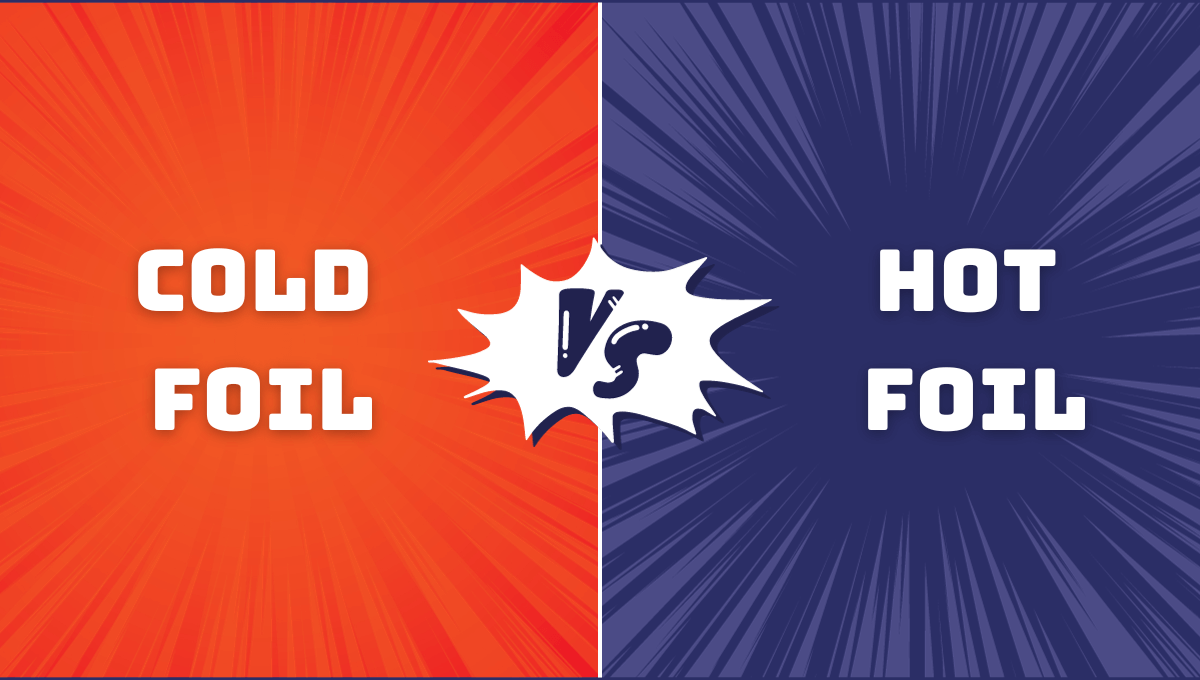Cold Foil Vs. Hot Foil for Labels

There are many techniques to take your labels to the next level. Manufacturers go one step ahead using the latest techniques to create labels that outshine their competitors. After all, a label is a very important part of your packaging and branding.
They are the first point of contact between your product and the customer. You must create a long-lasting impression through it. That makes your consumer remember the shopping experience forever.
That's why businesses are transitioning to using foils.
It turns a simple and boring label into elegant and luxurious. However, it's not as simple as you think. There are two primary categories from which you can choose: cold and hot foil.
But how do you know which one is suitable for your business and product?
In this article, we'll explore the differences between both categories and how you can determine the right choice for your label project.
So, let's dive in.
What is Cold Foil?
It is a printing and decorative technique that produces various printed materials. These materials can be labels, packaging, or any promotional item in general.
A thin layer of metallic or colored foil is added to a substrate: paper, cardboard, or plastic. You don't need to apply any heat to the substrate.
If you want to create an eye-catching finish, this is a suitable technique to achieve that. It is also known as cold stamping or cold foil transfer.
What Is The Process Of This Technique?
In this process, a flexographic printing press is used. An adhesive that is UV-curable is printed on the substrate. This substrate can be paper, cardboard, or film in any shape or design.
This foil is pressed hard onto the substrate through the nip pressure rollers. After that, the product is exposed to UV light. In the last step, the foil is removed. So there is no adhesive present anymore.
Results
This process has fine detail, and its consistency makes it suitable for designs in which maximum accuracy is required. For example, use this technique if you want small text on the labels but want more accuracy. Due to the wide range of colors, you can use it according to your brand colors.
Pros:
You need to know the pros to start using this technique for your labels. So here are some of the pros of using this method that you need to know.
- Intricate Designs: It is well-suited for intricate and detailed designs. It allows the precise placement of foils, making it ideal for complex patterns, fine lines, and small text.
- Color Options: It is available in a variety of colors, including metallic finishes, holographic patterns, and multi-colored designs. This wide variety allows for creative and eye-catching effects.
- Cost-Effective: This is often more cost-effective than other stamping methods. It doesn't require heated dies, which can reduce production costs.
Cons:
There are also some cons that you must keep in mind before using this approach.
- Less Shine: While cold foil can produce a shiny finish, it may not achieve the same intense shine as hot foil stamping.
- Production Speed: This technique is typically slower than other methods, such as hot foil stamping. This might be a consideration for large-scale production runs with tight timelines.
What Is Hot Foil?
Hot foil labels (or stamping) is a technology for labeling in which heat and pressure are used. It is transferred on the metallic foils and the label's surface. So here's how the process goes.
Heat or pressure → transferred to metallic foils → applied on the label surface.
Due to the usage of a hot foil stamping machine, the metal plate is heated. It presses on the label, and as a result, you get a shiny metallic finish.
This approach is used in various ways, especially product labeling. It's used for branding, promotional packaging, and many more purposes.
What Is The Process Of This Technique?
You have already gotten a glimpse of how this process works. But here's an analysis to understand this process better.
A metal stamp, which will later become a foiled design, is created during this method. It is then mounted on a stamping machine above the paper.
Once you've heated the stamp, the sheet of foil runs between the stamp and the paper. What's its benefit?
It is extremely beneficial because the foil is affixed to the surface when pressure is applied to the paper. Now, this pressure will make the design more noticeable.
Results
If you want a lustrous look for your labels, then with hot stamps, you can achieve it. In comparison to cold foil, the material of these colors is deeper and much more distinctive. The number of shades is increasing to make your labels more appealing to the customers.
Pros:
Now that you know about this technique, let's discuss some of the pros of this technology.
- Exceptional Shine: It produces a remarkable, intense, highly reflective metallic shine.
- Intricate Designs: This allows for precise and finely detailed designs, including small text, intricate patterns, and complex graphics.
- Durability: The foils applied through this technique are durable and resistant to wear and tear. It can withstand handling and environmental factors, making it suitable for premium products and packaging.
Cons:
You must understand the cons of every technique to decide if this technology is of any significance to you. Let's discuss some cons.
- Cost: It can be relatively expensive compared to other printing and finishing techniques due to the cost of custom dies, foils, and the additional production time required.
- Production Speed: This technique typically takes longer than other printing methods, affecting production timelines for large quantities.
Cold Foil vs. Hot Foil
Now, let's discuss the primary part of this article, which is the biggest difference between these two labeling technologies. Here's a table of differentiation that will ensure you understand both topics comprehensively.
|
Aspect |
Cold Foil |
Hot Foil |
|
Heat requirements |
Does not require heat; UV-curable adhesive |
Requires heat for transfer of foils |
|
Shine and reflectivity |
It provides a good shine but is less intense |
Offers exceptional shine and high reflectivity |
|
Materials |
Suitable for various label materials |
Versatile and can be used on different substrates |
|
Cost |
Generally more cost-effective |
It tends to be more expensive |
|
Production process |
Slower production process |
Faster production due to heat |
|
Waste generation |
Minimizes waste due to foils |
It may generate some waste because of foils |
|
Environmental impact |
Energy-efficient (low energy consumption) |
Requires more energy (due to heat) |
Which Labeling Technique Is Right For You?
You might be wondering about the best labeling technique for your next label project. Is it cold or hot foil?
Here's a simple guide to finding the best technique according to your requirements.
Budget
You want your design to stand out if you don't have a big budget yet. Then cold foil is a better option for you. It's a budget-friendly option, and you'll get amazing results even on a small budget.
But why is it cost-effective?
It's because you don't need to use any heated dies or energy needed for stamping. Moreover, hot foil stamping is costly because the metal dies are custom-made.
Design Complexity
Suppose your label design has really intricate and finely detailed elements. It can be text, illustrations, complex patterns, or intricate graphics. Then which option should you opt for?
In this case, both techniques are ideal.
Cold foil allows for precise placement, making the design more lively and accurate. On the other hand, the heat and pressure applied in hot foil stamping ensures that even the finest lines and details are accurately reproduced.
Material Compatibility
The most important thing you should consider in this process is the compatibility of the material. If we talk about cold foil, then it's versatile and compatible with various label materials, including paper and film. Therefore, you get enough flexibility in material selection.
However, hot foil is also versatile. But there are certain limitations.
It might not be the ideal choice, especially when it comes to heat-sensitive materials. However, if you still want to choose it, ensure your chosen substrate can withstand the heat.
Brand Perception
Brand perception is extremely important. You don't want your designs to look like a poor copy. Cold foil can produce attractive labels. But it may not convey the same level of luxury and premium quality perception as hot foil.
So, ask yourself how you want your brand to be perceived by consumers.
Hot foil is a better option if you want your designs to look high-end and have a luxurious finish.
Conclusion
Both labeling techniques provide plenty of advantages. If one is faster than the other, the technique provides exceptional detail.
Choosing the right solution can make your simple labels eye-catching and beautiful. It'll make your project stand out and get the attention of customers.
But you must have the right equipment and expertise because one mistake can mess up your hard work.
If you're still unsure about which labeling technique to use, don't hesitate to contact Altro Labels. We have helped numerous businesses design labels that are according to business needs. We have a team of experts that will ensure your labels win the hearts of your customers. Reach out to us today.
